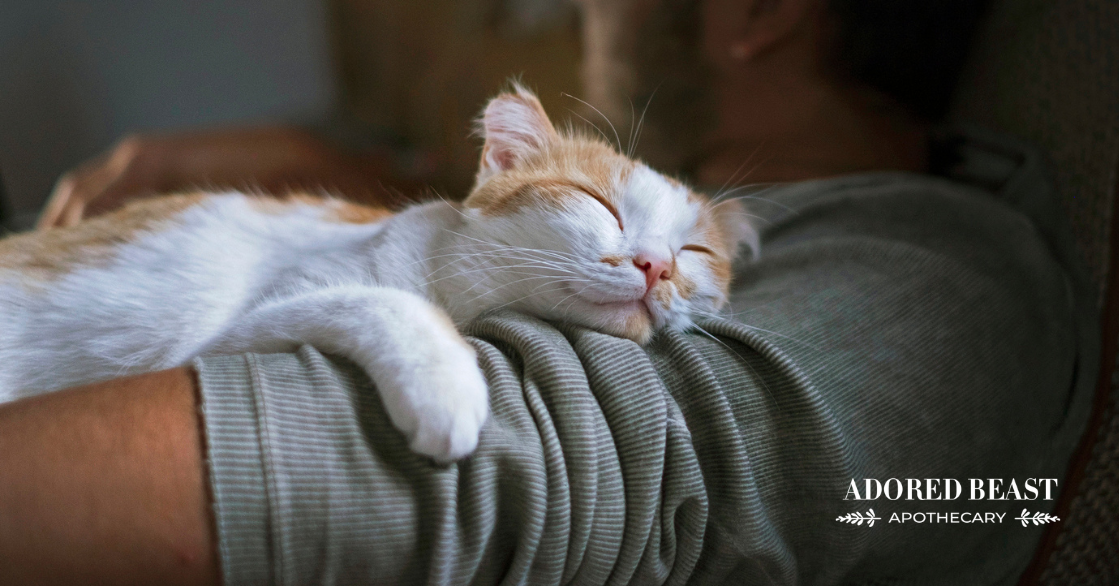Oh, dreaded crystals in cat urine… we get questions about this issue several times a week. Unfortunately, it’s a very common occurrence for our furry felines.
If your cat has ever been diagnosed with crystals, you know how stressful it can be for both of you. Crystals can lead to discomfort, urinary blockages, or even emergency situations if left untreated.
From a holistic standpoint, it’s not just about treating the crystals – it’s about understanding why they’re forming and how to support your cat’s body to prevent them naturally.
Let’s break it down.
What Are Crystals in Cat Urine?
Crystals in the urine are microscopic structures that form when certain minerals (like struvite or calcium oxalate) clump together. They can sometimes form larger stones (uroliths), which may block the urinary tract. This is especially dangerous for male cats (and we’ll get to that in a minute).
Common types of crystals include:
- Struvite: Made from magnesium, ammonium, and phosphate; more common in younger cats. These form in urine with a high pH (generally above 7.5).
- Calcium Oxalate: Often found in older cats; less likely to dissolve on their own. They form in urine with a very low pH (generally below 6.5).
These crystals don’t always cause symptoms, but when they do, you may notice:
- Frequent trips to the litter box
- Straining to pee/difficulty peeing
- Crying when urinating
- Blood in urine
- Frequent licking of the genital area
- Peeing outside the litter box (especially if they associate the box with pain)
If you notice any of these signs, a trip to the vet is a must.
What Causes Crystals to Form?
From a holistic perspective, crystals in cat urine are a symptom of imbalance, not just a random occurrence. Several factors can contribute:
- Dehydration: Cats are notoriously bad at drinking water, especially if they eat dry food.
- Highly processed diets: Dry kibble, in particular, can lead to alkaline urine (especially in struvite crystal cases).
- Stress: Emotional health is often overlooked but plays a huge role in urinary health.
- Imbalanced minerals: Too much or too little of certain minerals can trigger crystal formation.
- Urinary pH imbalance: Urine that’s too alkaline or too acidic encourages crystal development.
Urinary Bloackages
One of the biggest issues with crysals, particulary with male cats, is urinary bloackages.
If your veterinarian says yes, your cat is blocked, they may recommend a catheter. At this point, ask if pain medicine and a muscle relaxant can be tried first. Ask for their personal opinion on your unique situation.
If they say, “absolutely no way, your cat is totally blocked, we need to clear it out right away,” – do it! This is a life-threatening situation.
However, if they say “there is a blockage, but the bladder is small, so sure, let’s try the pain meds and muscle relaxant first and see if they’ll pee on their own” – do it. Most of the time, blockages happen with male cats and they come from crystals. Female cats get crystals just as often as male cats, but they don’t have the teeny tiny urethra. When a cat has crystals, what winds up happening is that when the cat is urinating, it irritates the lining of the urethra. Then the urethra gets inflamed, getting even thinner. Then it starts to spasm, and nothing can go anywhere. The crystals get stuck, blocking the urethra.
Now, here’s why this is important. If the crystals get stuck, when you use a catheter, you’re trying to push through them. A lot of time this causes scarring in the urethra. Ultimately, your cat can be more prone to getting blockages than before. So, if there’s a chance that the drugs may work, and it’s safe to wait and see if they do, it’s always better.
But again, if your vet says no, you absolutely have to unblock it now – do it. Don’t wait.
How to Discourage Crystals Naturally
The goal isn’t just to get rid of the crystals—it’s to support a healthy urinary system long term. Here are some natural, holistic strategies to help prevent them:
1. Hydration is Key
Encouraging your cat to drink more is one of the most important things you can do. As a general rule, cats get their moisture from their food (many don’t drink enough), so you want to keep them hydrated.
- Wet food over dry: Switch to high-quality canned, raw, or lightly cooked food to increase moisture intake.
- Broths: Add bone broth or tuna water (unsalted) to meals.
- Fountains: Many cats prefer running water – fountains can encourage more drinking.
- Multiple water bowls: Place bowls throughout your home to make drinking easier.
2. Feed a Species-Appropriate Diet
Cats are obligate carnivores. Diets that mimic what they would eat in nature help maintain healthy pH levels and reduce crystal risk.
- Avoid high-carb, grain-heavy foods.
- Choose whole, limited-ingredient diets with real meat.
- Consider raw or gently cooked meals with veterinary guidance.
And feed to balance pH.
- To lower pH (for struvite crystals), feed things like fresh cranberries, apple cider vinegar, and fermented raw goat milk.
- To increase pH (for oxalate crystals), feed things like green, leafy veg, broccoli, cabbage, cauliflower, pumpkin, apples, berries, oranges, cantaloupe, watermelon, and/or pineapples.
3. Herbal and Natural Support
Several herbs and supplements can gently support urinary tract health:
- D-mannose: A sugar that helps flush bacteria and reduce inflammation.
- Cranberry (in small amounts): May help acidify urine and reduce bacteria adhesion.
- Marshmallow root: Soothes the urinary tract lining.
- Horsetail: Rich in silica, supports urinary tissue healing.
- Homeopathic berberis and hydrangea: These are indicated for supporting the dissolution of crystals.
4. Minimize Stress
Stress changes body chemistry, lowers immunity, and can trigger urinary issues (especially in cats with feline idiopathic cystitis).
- Provide vertical space (cat trees, shelves)
- Enrich their environment with toys, puzzle feeders, and window perches
- Use calming aids like pheromone diffusers or calming herbs like valerian or catnip
- Keep a predictable routine (feeding, play, quiet time)
5. Keep That Litter Box Clean and Safe
Painful urination can make cats avoid the box, which only adds to the problem.
- Scoop daily and change litter regularly
- Have one box per cat, plus one extra
- Place boxes in quiet, low-traffic areas
Our Easy Peesy Protocol was developed specifically for bladder health and urinary crystals, to help discourage crystal formation and help support urinary tract health.
Crystals in cat urine are more than a urinary issue – they’re a signal that something in the body is out of balance. By addressing the root causes through hydration, diet, stress reduction, and gentle natural support, you can help your cat feel better and avoid future flare-ups.
As always, work with a veterinarian, ideally one open to integrative or holistic care, to monitor your cat’s progress and make sure you’re on the right path. Your cat’s body wants to be well. With the right support, you can help them stay balanced, naturally.












